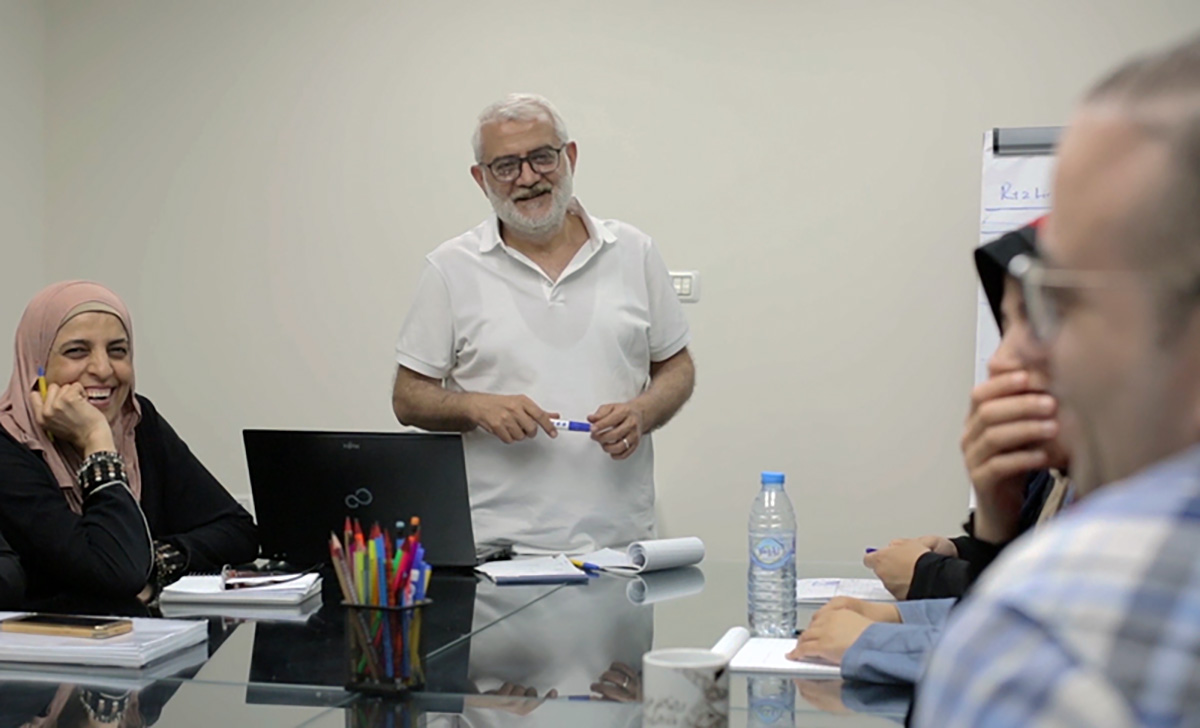Interview with Dr. Mustafa Elmasri
Dr. Mustafa Elmasri is a Palestinian psychiatrist. He received his medical degree from Alexandria University and his psychiatry degree in 1996 from Ain Shams University in Egypt. Dr. Elmasri started working as a psychiatrist at the Gaza Community Mental Health Programme, as a clinical psychiatrist, researcher, and clinical supervisor. He has worked in several developing countries on the design and implementation of psychosocial and mental health programs for children, women, and adults exposed to trauma from war, conflict, and political violence. He is currently working with UPA, as the clinical supervisor and trainer for the Healing through Feeling Program.
Tell us about yourself and why you joined the UPA Family?
I started my medical practice as a general practitioner in Saudi Arabia. I returned to Gaza to work with the Gaza Community Mental Health Program in 1992. After specializing in psychiatry, I worked in many countries across Asia and Africa as a psychiatrist consultant, trainer, and researcher.
My interest in mental health stated early in my career. Living in Gaza under the burden of occupation, blockade, and discrimination, the feelings of oppression and restriction of liberty, and the constant worry about safety are pervasive. Under these conditions, you learn the lessons of how trauma affects the way you feel, think, and relate to yourself and to others. Given the proper support you can also learn how to deal with the frustration of your ambitions, and the shattering of your dreams, by keeping hopeful and being innovative and by helping others deal with their problems.
In my experience, I learned that humans are more alike than they are different or at least they suffer and show pain and joy in similar ways. Once you break through the barriers of language, cultural artifacts, and politics, you are there with your ‘self’ or with someone who shares a lot with you.
Although I lived and worked in many counties, rich and poor, my heart and mind remained attached to Palestine and Gaza. I met Palestinians, Jordanians, and Lebanese people in these countries mostly sharing my nostalgia for return and eager to help their own people back home.
There are three related reasons that attracted me to UPA:
First, the team. A group of dedicated, ambitious youth, well-informed about the problems they are dealing with, very eager to learn and teach. The team is well supervised and cared for, and not authoritatively led by dogma and ideology. They take good care of themselves and of each other. They easily form social and professional links with their community based on respect and equality.
Secondly, UPA’s approach to mental health. Besides being evidence-based and applicable locally. The trauma-informed, preventive, and empowering approach meets my preferred working methodology, and the one I have more experience with. Having the opportunity to implement it in my own country was an irresistible opportunity.
Finally, the organization. UPA, fits the description of a Palestinian family. With people embedded on the ground, sowing the seeds of life and prosperity and others in diaspora yearning to support and advocate for their cause. It is committed to human rights and philanthropy. That caught my eye very early on.
I was offered the opportunity to be part of this, and I found myself able to contribute without causing burden or harm. In short, I felt at home, felt needed, and empowered to contribute.
Can you tell our readers about the state of mental health services in the Gaza Strip and why the Healing through Feeling Program remains a critical need?
With its 1.9 million inhabitants squeezed in a narrow strip of land of 140 square miles, and surrounded by a security fence, guarded by aggressive, trained to kill and trigger-happy Israeli soldiers. Gaza has been described as an open-air prison, and rightly so. But it is also a killing field, being continuously strangled by a tight siege, and regularly bombarded through air, land, and sea assaults, killing hundreds and leaving thousands of people with physical disabilities and psychological scars.
The people of Gaza, especially children and youth, have led the struggle for survival and liberation and have suffered the most casualties. Nevertheless, they persisted and persevered in education and innovation to keep Gaza a livable space until now. Their hope for return and liberation as fresh as it was in the hearts of their grandparents.
Mental health services are provided mainly by the Ministry of Health (MOH) psychiatric hospital and five community mental health centers. The United Nations Relief and Works Agency (UNRWA) provides basic mental health services and a school counseling program manned with 200 education counselors. A good number of NGOs (the number varies according to the amount of funds available from international donors) have active projects but mainly focused on the psycho-social aspects and dismissing mental health as a specialty service to be provided by the Government and private sector. The small private sector service cannot be afforded by the average citizen and is never covered by third party payment.
Most mental health services are reactive, emphasize the treatment component, and are operated by busy and overworked psychiatrists, psychologists, and managers.
Child mental health is not recognized as a priority issue and preschool mental health is not even an entry in the mental health plan. Mental Health Professionals (MHPs)are doing their best, but as expected they are overwhelmed with severe and chronic mental health and substance abuse problems, leaving little space for mental health prevention and promotion. Attempts to integrate mental health in primary health care by MOH and UNRWA are facing severe systemic problems, and child mental health is not included in the program.
Currently there are less than 20 psychiatrists serving the whole population. The Mental health services also have a shortage in qualified MHPs, such as clinical psychologists and social workers and mental health nurses, who are the main force for treatment and prevention. The thousands of graduates in these fields have but a few costly venues for specialization, and few job opportunities. They are usually offered short theoretical training and limited time employment after emergencies, never enough to build experience or create a career path.
Child mental health is seen through the same lens as adult psychiatry, focusing on the severe problems like epilepsy and behavioral disorders from a treatment perspective. Trauma work and prevention receive attention only after emergencies in the form of direct child focused ventilation and recreational activities, for at least what the amount of funding permits. Preschool children and youth outside school are usually excluded from planning.
Moreover, with the increasing rate of crises around in the world, and the consequent dwindling regional and international support, the overburdened mental health system is in danger of complete paralysis.
Since its inception, our Healing through Feeling (HTF) Program provided trauma-informed psycho education to thousands of parents and caregivers in the Gaza Strip. What are the most pressing issues you learned about in your role and how does the program address them?
Let me start by saying that the most pressing and dangerously critical issue left is the siege and end the blockade of Gaza. It does not need more research or evidence to show that any reconstruction or development will be futile if people are kept in a prison with no work and no medicine, and are constantly targeted by bullets and bombs to destroy their homes, livelihoods, and lives.
But since the international community stands helpless in that regard, we as professionals in every domain try hard to maintain life and hope. Like our community, we never give up.
Healing through Feeling (HTF) offers a new approach to mental health in general, and especially fills a service gap in early childhood mental health services. The program focuses on prevention and early intervention for child mental health problems through empowering caregivers, parents, teachers, and service providers. We do that by implementing psychoeducation sessions and skills training
Much can be done through prevention. The majority of risk factors for child and youth mental health problems are preventable. For example, the current concern about substance abuse, self-harm, and suicidal behavior among youth are linked to early childhood trauma and adversity. If recognized in time and managed, then we can prevent these problems from arising in the future.
HTF also works through a holistic approach, meaning that other biological and social adversities, whether neurological, nutritional, familial, are also considered and managed through referrals and consultations with other specialists.
We also provide consultations and counseling for parents and teachers on mental health issues. A child mental health problem is never an individual affair. Trauma and adversity lies in the relationship with the parent or caregiver, not at all bad news, since it implies that recovery and healing also depend mainly on that relationship and all evidence based therapeutic interventions for trauma draw on the strengths of this relationship.
For example, when a mother recognizes that her own trauma from war, poverty, or violence, impacted the communication channels with her child, making her intolerant or punitive, thereby making her child more aggressive and stubborn, HTF helps the mother apply the necessary skills, making the process natural and healing.
We learned that there is much that we can do, before mental illness sets in, and with methods other than treatment (drugs or formal therapy). We also learned that much of what can be done in prevention and healing can be transmitted through training for MPHs and psycho-education to the community including especially parents of preschool children and kindergarten teachers.
As a supervisor, I leaned that skills can be better transmitted to MHPs as needed and when needed. Also, all skills and knowledge should fit in a structure and approach that is trusted and shared with the MHP. I learned that the team should be seen as both a group and as individuals. I learned that having the same experiences as a member of the community you serve is a double-edge sword and can be turned into an advantage if you thrive and survive, thus shifting the benefit to your colleagues and clients. We insist that individual support and supervision is a standard and necessary component of our model. As individuals, MHPs should be kept interested and motivated by attention to recognition of their personal and professional needs and resources.
How has the Healing through Feeling Program been received? What is a memorable experience you can share with our readers about the impact of the program?
HTF is received very well both by the professional and social communities, as it fills a gap in mental health knowledge and practice. The program bridges the gap between psychosocial and mental health services, invites clinicians to contribute to the psychosocial component by sharing their skills with psychosocial staff and recognizing the mental health value of psychosocial interventions like psychoeducation, parenting skills, and classroom interventions training. Clinicians can both advise and learn from such interventions and recognize their healing effect. HTF has links with the early education and child protection sectors and has participated in joint activities with many NGOs in the mental health and childcare sectors.
Children see us as friends of the family or of the Kindergarten, who help their parents and teachers understand them and provide better care for them. At times we are invited to share a class, provide play therapy with children, or join a class for observation and assessment. We recognize our role is to support and empower the natural healing process in the family or KG and not to replace it or create dependency. Our intervention is short to medium term, with clear structure and protocol. However, our relationship with the community we serve is open and long-term. We are trying to create a community around early childhood mental health that is led by caregivers and their children.

